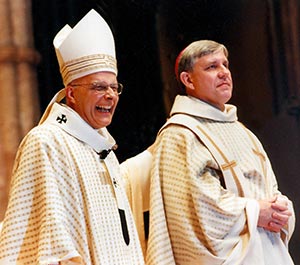Several years ago, Cardinal Francis E. George and Archbishop Jerome E. Listecki were talking about the cardinal’s Chicago predecessor, Cardinal Joseph L. Bernardin. They were talking about their admiration for Cardinal Bernardin, and how well loved he was. Cardinal Francis E. George presents then-Bishop Jerome E. Listecki to the congregation at Holy Name Cathedral, Chicago, after ordaining him an auxiliary bishop for the Archdiocese of Chicago, Jan. 8, 2001. (Catholic New World photo)
Cardinal Francis E. George presents then-Bishop Jerome E. Listecki to the congregation at Holy Name Cathedral, Chicago, after ordaining him an auxiliary bishop for the Archdiocese of Chicago, Jan. 8, 2001. (Catholic New World photo)
“It was interesting that Cardinal George said the one thing that stood out that he admired most about Cardinal Bernardin was that he died a public death,” Archbishop Listecki recalled April 20, noting that Cardinal Bernardin had “to continue to be a public person” in spite of the fact he knew he was dying.
Archbishop Listecki said it was ironic that Cardinal George was subjected to the same “public death” that Cardinal Bernardin experienced.
“It’s a thousand questions about how’re you feeling; a thousand questions about what’s the prognosis; a thousand questions about your ‘vision’ for the short time you have,” the archbishop said. “It is almost a living wake.”
Archbishop Listecki said that Cardinal George, who died April 17 at the age of 78 after a nearly 10-year battle with cancer, accepted that.
“He demonstrated the courage of someone who lived his faith as a leader and literally looked upon his impending death with grace and dignity as an example to all of us,” the archbishop said.
Archbishop Listecki said he and the cardinal “stayed away from the death talk,” focusing instead on their love for the church.
“As a believer, we believe we’re not embracing death, a finality, we’re embracing life, so why shouldn’t we embrace life now that we’re living with the understanding that God will take care of us as he embraces us in the transition from this life to the next?” Archbishop Listecki said.
Calling it an “honor” that Cardinal George submitted his name to the Holy See as a candidate for bishop, Archbishop Listecki said, “I have a lot to be grateful for to Cardinal George.”
In addition to Archbishop Listecki, Cardinal George ordained nine other bishops. The first was Auxiliary Bishop Joseph N. Perry of Chicago in 1998; the last was Bishop David J. Malloy as bishop of Rockford, Illinois, in 2012. Both are priests of the Archdiocese of Milwaukee.
He was one of eight cardinals to attend the installation of Archbishop Timothy M. Dolan as archbishop of Milwaukee, Aug. 28, 2002. He also gave a Pallium Lecture titled “At the Holy Center: Pope Benedict XVI,” Jan. 31, 2006. The cardinal had been scheduled to give the Pallium Lecture on April 5, 2005, but had to cancel it as he went to Rome following the death of Pope John Paul II three days earlier.
By retiring in 2014, Cardinal George, the first native Chicagoan to head the archdiocese, accomplished what he often joked was his aspiration – to be the first cardinal-archbishop of Chicago to step down from the job, rather than dying in office, as his predecessors had. He was succeeded last September by Archbishop Blase J. Cupich.
A childhood bout with polio left the prelate with a weakened leg and a pronounced limp throughout his life. When the archdiocesan seminary rejected him because of his disability, he attended the Oblate-run St. Henry Preparatory Seminary in Belleville, Illinois. He was ordained a priest Dec. 21, 1963.
In a catechesis session during World Youth Day in Dusseldorf, Germany, in 2005, Cardinal George told the youths that having polio at the age of 13 left him, “a captive in my own body. I soon learned that self-pity got me nowhere. Faith was the way out, because in faith I was not alone, and good can come of something that appears bad at that time.”
He was a philosophy professor, having earned doctorates in philosophy and sacred theology in ecclesiology, and regional provincial and then vicar general for the Missionary Oblates of Mary Immaculate, before being named bishop of Yakima, Washington, in 1990. Nearly six years later he was appointed archbishop of Portland, Oregon. Less than a year later, St. John Paul II appointed him archbishop of Chicago. He was elevated to cardinal in 1998.
Cardinal George was president of the U.S. Conference of Catholic Bishops from 2007 to 2010, which made him the public face of the bishops’ efforts to help shape what became the Affordable Care Act. In his final address to the body of bishops as their president in November 2010, he criticized those who define the church’s usefulness by whether it provides “foot soldiers for a political commitment, whether of the left or the right.”
Cardinal George’s funeral Mass was celebrated Thursday, April 23, at Holy Name Cathedral, Chicago.
With information provided by Catholic News Service.
